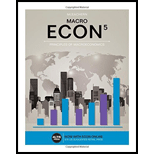
The importance of the concept of scarcity in economics and to determine if a resource is scarce.
Concept introduction:
Scarcity of resources means lack of resources in comparison to wants.
Explanation of Solution
The scarcity of resources is determined when demand is more than availability and the price of resources is more than zero. The human demands are unlimited and means to meet those wants are limited. This situation requires the efficient allocation of scarce resources in such a way that all the resources should be optimally utilized (no resource should go waste).
The concept is important to the definition of economics because it studies the human behavior as a relationship between unlimited wants and scarce resources. It is the science which studies how to make a choice between alternative uses of scarce resources. Scarcity is itself a big economic problem. Without it, economies studies will have no value.
Want to see more full solutions like this?
Chapter 1 Solutions
ECON: MICRO4 (New, Engaging Titles from 4LTR Press)
- Suppose the government imposes a fuel levy, identify, and discuss at least two ways in which this increase might have an effect on GDP growth, making use of the assumptions of the Keynesian model of income and expenditure.arrow_forwardCan you please assist Suppose the Government of Botswana has decided to implement a national minimum wage, but they have not yet decided at which rate to set this wage. With the aid of two separate diagrams, discuss the possible implications of setting this rate (i) at and (ii) below the equilibrium wage rate, respectively.arrow_forwardIf interest rate parity holds between two countries, then it must be true that: Question 3 options: The interest rates between the two countries are equal. The current forward rate is an unbiased predictor of the future exchange rate. The interest rate differential between the two countries is equal to the percentage difference between the forward exchange rate and the spot exchange rate. Significant covered interest arbitrage opportunities exist between the two currencies. The exchange rate adjusts to keep purchasing power constant across the two currencies.arrow_forward
- If interest rate parity holds between two countries, then it must be true that: Question 3 options: The interest rates between the two countries are equal. The current forward rate is an unbiased predictor of the future exchange rate. The interest rate differential between the two countries is equal to the percentage difference between the forward exchange rate and the spot exchange rate. Significant covered interest arbitrage opportunities exist between the two currencies. The exchange rate adjusts to keep purchasing power constant across the two currencies.arrow_forwardSuppose the indirect exchange rate for the Canadian dollar is 0.93. Based on this, you know you can buy: Question 2 options: $1 U.S. for $1.93 Canadian. $1 U.S. for $1.08 Canadian. $1 U.S. for $0.93 Canadian. $1.93 U.S. for $1 Canadian. $1.08 U.S. for $1 Canadian.arrow_forwardAccording to the relative purchasing power parity theory, high inflation in country A and low inflation in country B will cause the value of country A's currency to appreciate relative to that of country B. Question 1 options: True Falsearrow_forward
- How might different tax structures influence consumer behavior in luxury versus essential goods?arrow_forwardWhat is a competitive market?arrow_forwardلا. Assignniend abcpain the the three type of state- and explaining of the decannolly you know + 29 Explain Cu Marginal utility Jaw State the lid of diminishing. Explain the Concept of the aid of ha the relations and marginal uitity. Marginal finishing حومarrow_forward
- How does the change in consumer and producer surplus compare with the tax revenue?arrow_forwardConsidering the following supply and demand equations: Qs=3P-1 Qd=-2P+9 dPdt=0.5(Qd-Qs) Find the expressions: P(t), Qs(t) and Qd(t). When P(0)=1, is the system stable or unstable? If the constant for the change of excess of demand changes to 0.6, this is: dPdt=0.6(Qd-Qs) do P(t), Qs(t) and Qd(t) remain the same when P(0)=1?arrow_forwardConsider the following supply and demand schedule of wooden tables.a. Draw the corresponding graphs for supply and demand. b. Using the data, obtain the corresponding supply and demand functions. c. Find the market-clearing price and quantity. Price (Thousands USD) Supply Demand2 96 1104 196 1906 296 270 8 396 35010 496 43012 596 51014 696 59016 796 67018 896 75020 996 830arrow_forward


 Essentials of Economics (MindTap Course List)EconomicsISBN:9781337091992Author:N. Gregory MankiwPublisher:Cengage Learning
Essentials of Economics (MindTap Course List)EconomicsISBN:9781337091992Author:N. Gregory MankiwPublisher:Cengage Learning Brief Principles of Macroeconomics (MindTap Cours...EconomicsISBN:9781337091985Author:N. Gregory MankiwPublisher:Cengage Learning
Brief Principles of Macroeconomics (MindTap Cours...EconomicsISBN:9781337091985Author:N. Gregory MankiwPublisher:Cengage Learning Principles of Economics 2eEconomicsISBN:9781947172364Author:Steven A. Greenlaw; David ShapiroPublisher:OpenStax
Principles of Economics 2eEconomicsISBN:9781947172364Author:Steven A. Greenlaw; David ShapiroPublisher:OpenStax Principles of MicroeconomicsEconomicsISBN:9781305156050Author:N. Gregory MankiwPublisher:Cengage Learning
Principles of MicroeconomicsEconomicsISBN:9781305156050Author:N. Gregory MankiwPublisher:Cengage Learning





